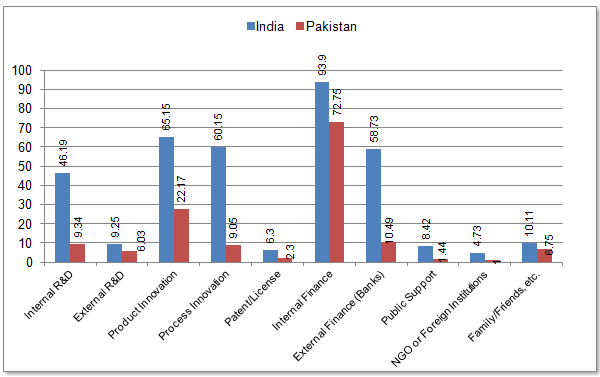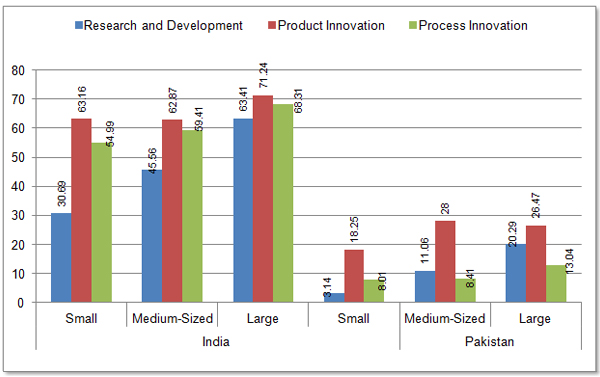External and Internal R&D would Benefit Pakistani and Indian SMEs

Please note that we are not authorised to provide any investment advice. The content on this page is for information purposes only.
Small and medium-sized enterprises (SMEs) play a vital role in the economic growth of a country. Specifically, in developing countries where poverty, unemployment, low income per capita, low literacy rate, and high inflation and interest rates can hinder economic growth, SMEs contribute significantly to the national income and provide employment opportunities (Moktan 2007).
Small and medium-sized enterprises (SMEs) play a vital role in the economic growth of a country. Specifically, in developing countries where poverty, unemployment, low income per capita, low literacy rate, and high inflation and interest rates can hinder economic growth, SMEs contribute significantly to the national income and provide employment opportunities (Moktan 2007).
However, SMEs have low survival rates than large firms because of resource constraints. Innovation is an important resource for a firm’s competitive advantage; it improves the firms’ knowledge-learning abilities. From the perspective of input resources, one of the most common indicators used to measure firm innovation is research and development (R&D) expenditure.
R&D performs two major functions: it generates new knowledge through product/process innovation and increases the firm’s absorptive capacity (learning effect) and, hence, innovative performance (product/process innovation).
However, internal R&D alone is not sufficient and SMEs’ use of external R&D (R&D collaborations) is equally important to achieve higher levels of innovation (Bergman 2010). A recent study investigates the impact of internal and external R&D on the innovation performance of SMEs in India and Pakistan.
SMEs in India contribute 17% to total gross domestic product (GDP) while the figure for Pakistan is around 40%. India’s SMEs employ nearly 15% of the national workforce (about 60 million people), account for 26 million enterprises, and contribute 45% of manufacturing output. In comparison, SMEs in Pakistan employ 75% of the non-agricultural workforce, account for 3.2 million enterprises, and contribute 30% of manufacturing output.
In R&D investment, India has the edge over Pakistan in overall R&D expenditure, which is equal to 1.0% of GDP compared with 0.3% for Pakistan. For cross-country comparison, micro-level data from the World Bank’s Enterprise Survey were obtained for 3,492 SMEs in India and 696 SMEs in Pakistan.
Regarding the comparison of innovation activities in Indian and Pakistan SMEs, a graphical assessment is provided. Figure 1 shows that approximately 46% of India’s SMEs undertook internal R&D compared with just over 9% of Pakistan firms. This suggests that Pakistan’s SMEs are much less engaged in internal R&D.
The level of external R&D undertaking is very low in both countries, suggesting poor alliances or collaboration with other firms and research institutions. Further, most (65%) of India’s SMEs were engaged in product innovation compared with only 22% of Pakistan’s SMEs. This information suggests that the low level of R&D by Pakistan’s enterprises results in low innovation output. A similar trend is found for process innovation. However, the patent and license output is low in both countries. This outcome could indicate that SMEs in both countries predominantly introduce incremental innovations.
Figure 1: Innovation Activities in Small and Medium-Sized Enterprises in India and Pakistan (%)
NGO = nongovernment organization, R&D = research and development.
Source: Author’s Own Calculations
SMEs in both countries rely mainly (over 70%) on internal sources of financing for their innovation activities (Figure 1), while Pakistan’s SMEs have substantially less access to external finance than India’s SMEs. Similarly, public support for innovation activities (R&D grants, subsidies, and tax credits) is low in both countries.
Similarly, Figure 2 provides information on R&D and product and process innovation by firm size. Approximately 31% of small firms in India are engaged in R&D and nearly 46% of medium-sized firms. A much higher share of large firms, 63%, are engaged in R&D. In Pakistan, only 3% of small firms undertake R&D compared with 20% of large firms. Overall, the link between R&D and firm size indicates that large firms in both countries undertake more R&D than do SMEs.
Figure 2: Research and Development, and Product and Process Innovation by Firm Size, India and Pakistan (%)
Source: Author’s Own Calculation
In India, 63% of SMEs have introduced product innovations. In Pakistan, only 18% of small firms have introduced product innovations. Overall, large firms are more engaged in innovation activities in both countries, which suggests they have better financial and knowledge resources. Pakistan’s SMEs have lower innovation capabilities than those in India.
Concerning the estimation analysis, this study reveals that SMEs engaged in both internal and external R&D may have significantly better innovation performance. In addition, the positive relationship between internal and external R&D implies a complementary relationship between these two types of R&D.
This suggests the likelihood that investing in internal R&D would increase the probability of also engaging in external R&D, and vice versa. This result confirms the findings of other researchers. Meanwhile, the negative association between a firm’s size and innovation output suggests that SMEs in both countries may be facing resource constraints.
Does internal and external research and development affect innovation of small and medium-sized enterprises? Evidence from India and Pakistan is republished with permission from Asia Pathways






